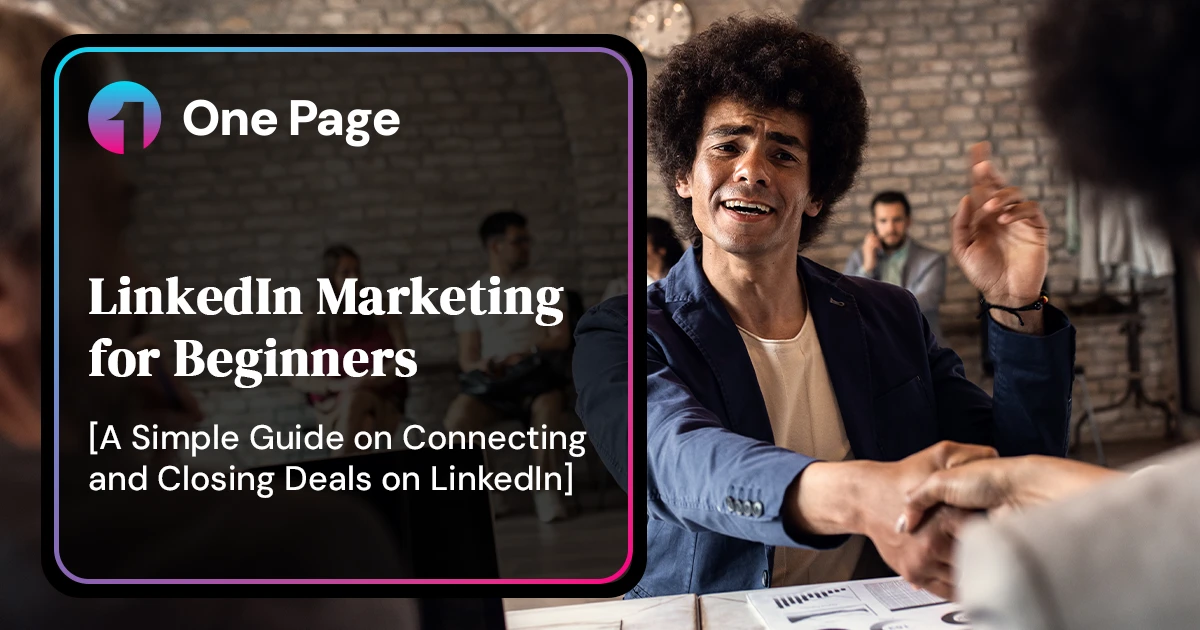Most people treat LinkedIn like a digital résumé. But for service-based businesses, B2B brands, and professional freelancers, it’s one of the most powerful platforms for lead generation and sales.
LinkedIn has over 1 billion users. More importantly, it has millions of decision-makers actively looking for solutions—not just scrolling for entertainment like on other platforms. Done right, LinkedIn marketing can turn your profile into a client-generating machine.
In fact, in my LinkedIn Lead Gen Strategy guide, I explain the exact steps to build a simple, streamlined system for attracting leads and booking calls consistently.
But here’s the thing: your LinkedIn strategy needs to go beyond just posting content. You need the right messaging, a clear funnel, and a smart strategy that captures and converts leads.
That’s what we’ll cover in this guide with step-by-step tactics to attract leads, build trust, and close more clients. And along the way, I’ll show you how a well-structured, one-page website can amplify the entire process.
What is LinkedIn Marketing?
LinkedIn marketing is, imho, the best way to use social media for building brand awareness, attracting hot leads, and selling your services. But for this to work in your favor, you have to go beyond just posting content or growing your network.
With the right LinkedIn strategy, you can position yourself as a trusted leader while using the platform to create a predictable, scalable lead generation system.
But what makes LinkedIn so effective compared to other social platforms?
- High-Intent Audience:
People don’t come to LinkedIn to kill time—they come to learn, network, and solve business problems. Unlike platforms like Facebook or Instagram, LinkedIn users are actively looking for professional insights and potential business solutions. - Powerful Targeting Options:
With LinkedIn, you can narrow your audience by job title, industry, company size, location, and even activity patterns. If you want to target Marketing Directors at SaaS companies with 50+ employees, you can do that within minutes. - Organic Reach Without the Paywall:
LinkedIn still rewards high-quality content with strong organic reach. Posts that spark conversations and offer value can get thousands of impressions—even if you don’t have a massive following or paid ad budget. - Direct Access to Decision-Makers:
LinkedIn gives you a direct communication channel to CEOs, business owners, and department heads. These are the people who can approve budgets and make decisions—without the need for gatekeepers or cold outreach. - Content That Lives Longer:
While tweets and Instagram posts disappear into the void within hours, LinkedIn content often continues circulating for days or even weeks—especially when it drives engagement through comments and reshares.
Attract and Convert More Leads on LinkedIn
Before you invest time in content creation or connection-building, make sure your website is ready to convert. Because even the best LinkedIn strategy will fall flat if visitors land on a generic site with weak messaging.
Start with a conversion-focused one page website that supports your LinkedIn efforts!
Get a One Page WebsiteWhy LinkedIn Marketing Is Your New for Lead Gen Superpower
When it comes to generating high-quality leads, most social platforms are a time-waster. So what makes LinkedIn different?
I believe LinkedIn is the undisputed champion for service-based businesses, B2B brands, and independent professionals. It’s where decision-makers spend time with purpose—learning, researching, and making real business decisions.

You might be thinking, “Hey Jef… that data is from 2014. It’s over 10 years old and probably doesn’t apply any more.”
Damn, you caught me! Well, let’s see just how active LinkedIn still is today.
Here’s a screenshot I took from SimilarWeb on 13 February 2025:
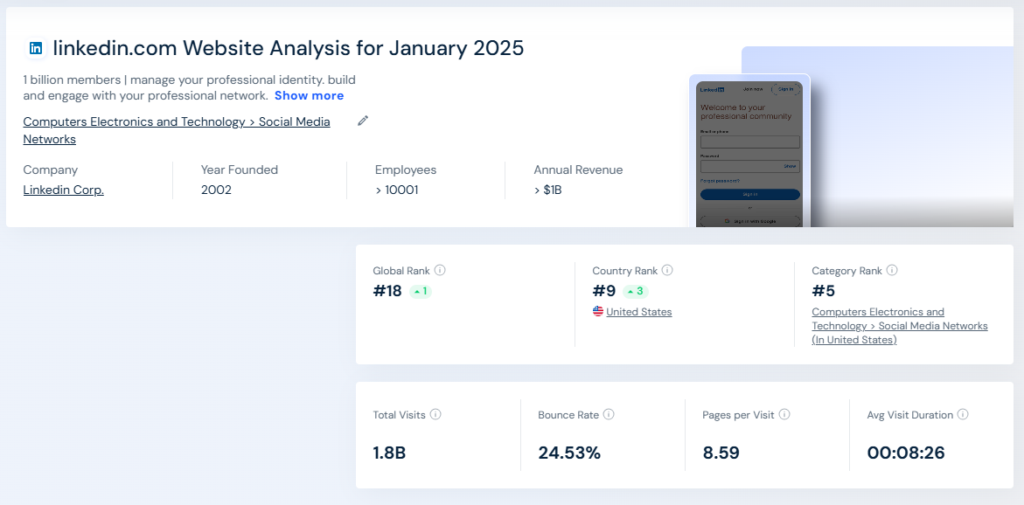
LinkedIn users spend an average of 8 minutes and 26 seconds per visit. That’s eight solid minutes of engaged, business-focused attention. If your content and profile show up during that window, you’re not just “present”—you’re positioned as a solution when the prospect is actively looking for one.
And when they’re ready to take action, all it takes is one well-placed message.
You’re One Connection Away From Your Next Client
Unlike cold emails or expensive ad funnels, LinkedIn lets you reach decision-makers directly.
- No gatekeepers.
- No generic contact forms.
- No layers of middle management to navigate.
When you engage with someone’s content or send a connection request, you’re interacting with the exact person who can sign the contract.
That’s what makes LinkedIn marketing so powerful: it compresses the sales cycle by connecting you with people who already need what you sell.
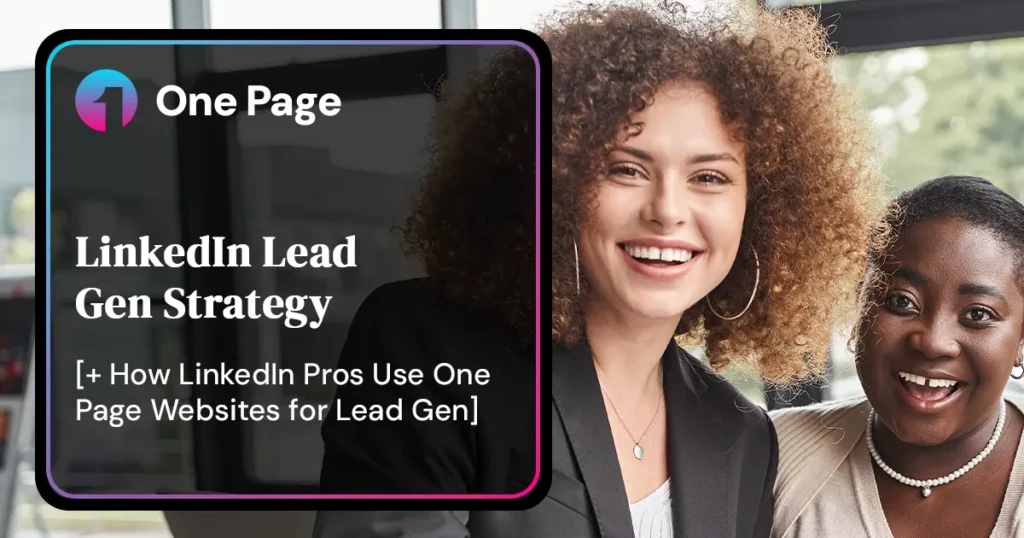
But if you want to win on LinkedIn, standing out isn’t as simple as throwing up a post here and there.
The competition is fierce with 97% of B2B companies use LinkedIn for marketing.
That’s why a haphazard approach won’t cut it. If you want to win on LinkedIn, you need a smart, streamlined system—a system that guides prospects from their feed to your profile, and then straight to a website designed to convert that curiosity into action.
The 3 Pillars of Successful LinkedIn Marketing
Let’s get this out of the way ASAP: LinkedIn can feel like a total mystery when it comes to generating leads.
You post content, engage with others, and maybe even send a few cold messages—but nothing seems to stick. It’s frustrating, especially when you know there’s potential.
The good news? You’re not alone. Many professionals struggle–including myself back in the day–to make LinkedIn work for them. But to get it to work, you have to stop trying harder and start using LinkedIn smarter.
And that’s exactly what we’ll cover here.
1. Optimize Your Profile for Conversions
Think of your LinkedIn profile as your storefront. When potential clients walk by, you have only seconds to grab their attention and convince them to step inside.
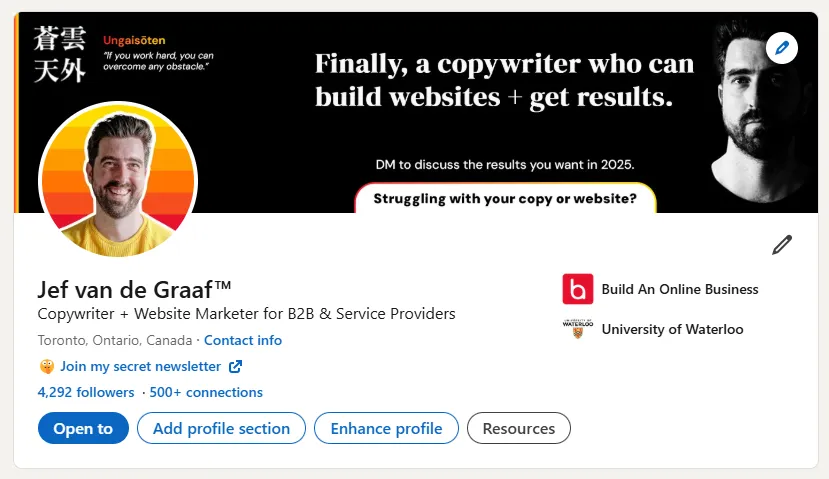
Here’s how you make that happen:
- Professional Profile Photo and Branded Banner:
First impressions matter. A clear, approachable headshot instantly makes you more relatable. Pair it with a branded banner that showcases your expertise and visually communicates what you do. - Value-Driven Headline and Client-Focused Summary:
Most LinkedIn headlines are boring and self-centered: “CEO at XYZ Corp”. But your headline should speak directly to your potential client’s needs. For example, “Helping B2B Companies Generate More Leads with Data-Driven LinkedIn Strategies”. In the summary, share your story. Talk about why you do what you do, and most importantly, how you can help them. - Clear Call to Action (CTA):
People won’t reach out unless you tell them how. End your summary with a clear, compelling invitation: “Want to see how LinkedIn can become your top lead gen channel? Book a free 20-minute strategy call today.”
LinkedIn users are already in a business mindset when they visit your profile. Make sure what they see gives them a reason to stay.
2. Create Content that Sells (Without Being Pushy)
Posting on LinkedIn without a strategy is like throwing darts in the dark. You might hit something, but it’s mostly luck. Instead, create content that educates, engages, and naturally draws in your ideal clients.
- Share Personal Stories of Success and Failure:
People resonate with real experiences. Share the highs and lows of your journey, especially the mistakes. For instance, “We tried a new outreach tactic last quarter and it failed miserably. But here’s what we learned and how we turned it around.” - Educate with Quick Tips and Case Studies:
LinkedIn users love actionable insights. Post quick tips that solve common problems in your niche. Even better, share case studies that show how you’ve helped clients succeed. For example, “Here’s how we helped a SaaS client boost demo bookings by 3x in just 60 days.” - Spark Conversations with Polls and Questions:
Engagement on LinkedIn isn’t just about reach—it’s about relationships. Post polls or ask questions that get people talking. Simple prompts like, “What’s your biggest challenge with LinkedIn marketing?” can lead to valuable conversations (and potential leads).
Remember, LinkedIn’s algorithm favors posts that generate interactions. The more people engage with your content, the more visible you become.
3. Master LinkedIn’s Advanced Search for Prospecting
At the end of the day, waiting around and hoping the right clients will magically find you is a waste of time. LinkedIn’s advanced search tools let you be proactive and intentional about your outreach.

- Use Filters to Find High-Intent Leads:
Search by industry, location, job title, and even current company. If you specialize in helping marketing directors at SaaS companies, you can find and connect with them in minutes. - Tap Into Second-Degree Connections:
Warm introductions work better than cold outreach. Identify mutual connections and ask for introductions. Or, simply engage with their posts before sending a message—it’s a small step that makes a big difference. - Save Your Searches and Track New Leads:
LinkedIn lets you save searches and get notified when new profiles match your criteria. This ensures your pipeline stays full without requiring daily manual work.
LinkedIn marketing doesn’t have to feel like guesswork. By optimizing your profile, creating content that resonates, and strategically prospecting, you can turn LinkedIn into a reliable source of high-quality leads.
The ‘Best’ LinkedIn Marketing Funnel
The best lead generation strategies guide potential clients through a simple, strategic funnel. To improve your chances of converting LinkedIn “strangers” toward sales conversations, this four-step funnel strategy will help you do just that.
Step 1: Identify Potential Clients Using Advanced Search
Start by using LinkedIn’s advanced search features to find people who fit your ideal client profile. Filter by industry, location, job title, and company size to narrow down your search.
For example, if you help SaaS companies with lead generation, search for “Marketing Directors” or “Sales Executives” at SaaS companies with 50–200 employees.
💡Pro Tip: Save your searches and set alerts to get notified when new profiles match your criteria. This ensures a steady stream of fresh leads without having to search manually every time.
Step 2: Engage with Their Content Consistently for 1–2 Weeks
LinkedIn is a social platform, and engagement builds trust. Spend time interacting with your target clients’ posts—like, comment, and share insightful thoughts. The goal here isn’t to sell but to make your name familiar and establish yourself as someone who adds value.
What to Comment:
- Ask thoughtful questions about their posts.
- Share quick insights or resources that might help them.
- Celebrate their wins and acknowledge their expertise.
Step 3: Send a Personalized, Curiosity-Driven DM
Once you’ve built a bit of rapport, it’s time to reach out with a personalized message. Avoid generic pitches; instead, lead with curiosity and focus on them.
Example Connect Request Message to Send:
- “Hey [Name], I came across your recent post about [topic]—loved your perspective. I’d be curious to hear more about how you’re approaching [specific challenge] these days. Let’s connect!”
- “Hi [Name], I love what you’re doing in [topic/industry]. I think us connecting is the next logical step. Best, [Your Name].”
- “Hi [Name], I’ve been following your content for a while now, and it’s always insightful. I’d love to connect and swap ideas on [industry/niche].”
- “Hi [Name], I came across your profile while researching [industry/field]. I’m always keen to connect with professionals who are doing interesting work—let’s connect!”
Keep these messages short, genuine, and focused on starting a conversation, not closing a sale.
Step 4: Book Calls Directly Through Your Profile Link
LinkedIn Premium allows you to add a single, clickable URL to your profile. When you post content, this URL is displayed prominently in the feed, giving your website ongoing visibility.
This is where a one-page website becomes your secret weapon.
Why a one-page site? Because it provides a streamlined, distraction-free experience for visitors. Instead of clicking through multiple pages, potential clients see everything they need in one place: your offer, your results, and a clear call to action.
The LinkedIn-Powered Website Advantage:
- Consistent Exposure: Every time you post, your profile (and your website link) appear in the feed, exposing your site to thousands of potential clients week after week.
- Faster Sales Cycles: A focused one-page site accelerates the decision-making process by delivering the essential information up front.
- Perfect for LinkedIn-Focused Growth: If your primary growth channel is LinkedIn, a one-page site is the perfect companion. It aligns with the platform’s ethos of clarity and simplicity.
Want to Make Your LinkedIn Marketing 10x More Effective?
You’ve got the strategy. Now make sure your website can handle the traffic and convert it into actual business. I’ll help you build a simple, high-converting one-page website designed specifically to support your LinkedIn marketing efforts.
LinkedIn Marketing Myths Debunked
Now when it comes to LinkedIn marketing, there’s no shortage of misconceptions that hold people back from using the platform to its full potential. Let’s break down five of the most common myths and uncover the truth behind them.
Myth 1: “I Need 1000s of Followers to Get Clients.”
Building a massive following might look impressive, but it doesn’t guarantee more leads or clients. Success on LinkedIn comes down to connecting with the right people, not the most people. A few hundred engaged connections who fit your ideal client profile are far more valuable than thousands of disengaged followers.
Myth 2: “Posting Every Day Is Essential.”
Consistency matters, but that doesn’t mean you need to post daily. Quality beats quantity every time. Focus on sharing valuable, engaging content that resonates with your target audience—even if that means posting just once or twice a week. The LinkedIn algorithm rewards meaningful interactions, not mindless posting.
Myth 3: “Only Big Companies Can Succeed on LinkedIn.”
LinkedIn isn’t just for Fortune 500 brands. In fact, small businesses and solopreneurs often find great success here because the platform makes it easy to build genuine relationships with decision-makers. Many professionals prefer working with smaller, more personable businesses over large corporations.
Myth 4: “You Have to Spend Hours Every Day on LinkedIn.”
LinkedIn marketing doesn’t have to take over your life. With a simple system—like 15 minutes a day for engaging with posts and sending a few personalized messages—you can maintain visibility and build relationships without burning out.
Myth 5: “My Website Doesn’t Matter If I Have a Great LinkedIn Presence.”
Your LinkedIn profile is your handshake; your website is the meeting room.
Even with a standout LinkedIn presence, people will want to visit your site to learn more about your services. That’s why having a high-converting one-page website is essential. It gives visitors a clear next step, whether that’s booking a call or learning more about what you offer.
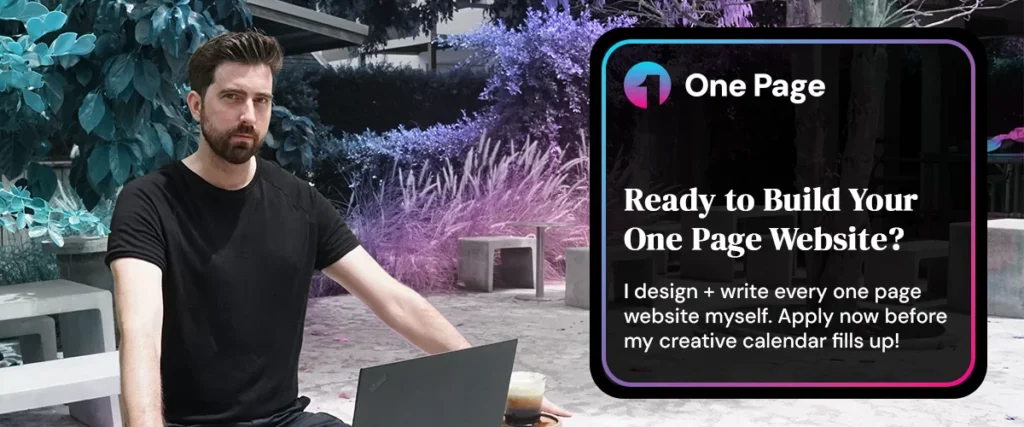
Need a LinkedIn-Optimized Website?
If you’re serious about turning LinkedIn into your top lead generation channel, you need a website that matches your momentum. I’ll help you build a simple, effective one-page website designed specifically to complement your LinkedIn marketing strategy.
